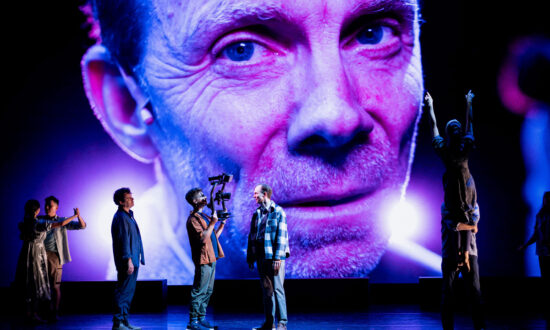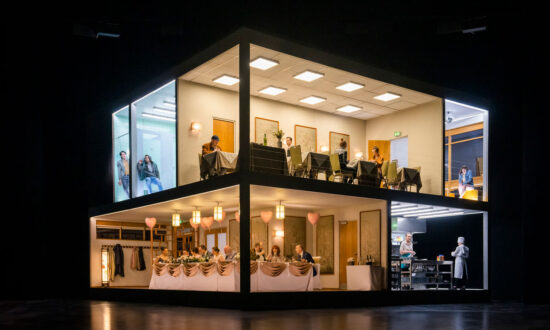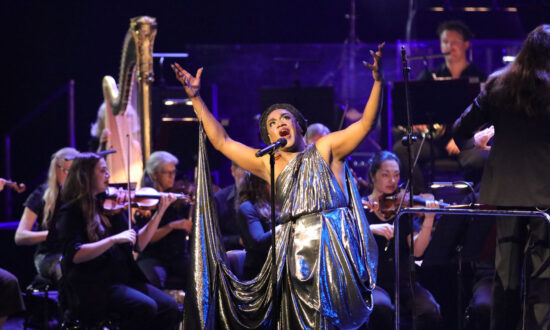When Ewen Leslie settled in to watch Eryn Jean Norvill’s star turn in 2020’s The Picture of Dorian Gray, director Kip Williams’ dizzying take on the Oscar Wilde classic was already being hailed as a rare triumph in an otherwise horror year for Australian theatre.
Leslie walked out of the theatre inspired, and perhaps a little terrified. Norvill had played Ophelia to his Hamlet a decade earlier, but as he watched his old mate “EJ” careen across the stage and screen, blazing through wig and costume changes as she portrayed more than two dozen characters, Leslie’s sense of admiration was accompanied by another, dangerous thought.
“I’d seen Dorian Gray, and I was absolutely bowled over by that show, and I really wanted to do something like that,” Leslie explains, then adds with a rueful laugh, “probably somewhat foolishly.”
Before long the Helpmann and AACTA-winning actor and star of TV series The Cry, Top of the Lake and Operation Buffalo found himself being put through many of the same paces as Williams and Sydney Theatre Company tackled another icon of gothic Victoriana: Robert Louis Stevenson’s The Strange Case of Dr Jekyll and Mr Hyde.
Like Norvill, Leslie plays the titular character – or characters – along with a motley gallery of supporting roles from a butler to a policeman, aided by pre-recorded material shot during a whirlwind rehearsal period. Around him and co-star Matthew Backer circle three camera operators, two stagehands and numerous screens in a feat of technical choreography that’s often as mesmerising as the story itself.

Actor Matthew Backer as Gabriel Utterson, surrounded by projected images of characters played by Ewen Leslie. Photo: Daniel Boud
“I’ve never actually counted them, and I don’t know the reason for that – I think it’s because if I counted them, I’d start to freak out,” he says of his many roles across the intricately blocked production. “I think it’s something like 400 marks on the floor? It’s something ridiculous. Anytime I’m told the number I try and instantly forget it – the floor itself is like a piece of art.”
There were other challenges, too. When Stevenson’s original first hit shelves as a paperback novella in 1886, its central mystery packed a shocking twist. Now, 136 years after it was first adapted for the stage, it’s a different story for audiences and creators alike.
“One of the challenges is that the big twist at the end – when you realise they’re the same people – would have been blowing people away,” Leslie says. “Whereas nowadays the twist tends to be the only thing people know about the story, you know? We’re sort of up against it from the word go.”
Like most audience members, Leslie had an osmotic awareness of the Jekyll/Hyde story gleaned through cartoons and pop culture, but little familiarity with the tensions of the original text.
“When I sat down and read the novel, I realised I didn’t know the story at all,” he explains. “I assumed Henry Jekyll was the lead character, whereas in fact the lead character is his best friend Gabriel Utterson, who basically is trying to work out what the relationship is between Jekyll and this strange, awful young man that’s showed up all of a sudden in Mr Hyde.”

Themes of duality and shame lie at the heart of Jekyll and Hyde. Photo: Daniel Boud
For Williams, grounding the story in the often-forgotten character of Utterson (played by Backer) and his journey of discovery was key.
“He’s really leant into the Hitchcock element of it, and he’s very much placed the audience with Utterson,” Leslie says. “I think he’s created something that once it starts, and you go on that journey with Utterson, it just spirals and spirals, and towards the end it – for lack of a better word – starts to go bonkers, in a way that’s really thrilling for audiences to watch.”
Like Dorian Gray, this production lets Stevenson’s original themes of duality, shame, and liberation speak to our present moment.
“It’s set during a time when your reputation was everything, and your social standing in the world was everything, and public opinion was everything,” Leslie says.
“And I think, as opposed to being a story about this guy who drinks a potion and then turns into something else, in fact that ‘something else’ is always sitting within him. He has spent his entire life pushing down this secret part of him, that he has been unable to talk to anyone about – denying it and trying to hide it from public view at all costs.
“Obviously it’s a horror story, and Mr Hyde is this monster, but really this ‘evil’ that Dr Jekyll talks about, it’s only evil in the way that he sees it, or more importantly in the way he feels society is going to see it. And I think that’s the part of the story that is sometimes lost a lot of the time in other adaptations, and it’s the part that Kip, myself, and Matt Backer were most interested in.”
Is Hyde, therefore, the monstrous, chemically-induced equivalent of a “burner” social media account – an outlet for the sides of ourselves we would never post on “main”?
“Absolutely,” Leslie says. “The idea of duality, and public life vs private life… you just have to flick through Instagram to think, ‘I don’t think this is really what’s going on in people’s lives’.

Get InReview in your inbox – free each Saturday. Local arts and culture – covered.
Thanks for signing up to the InReview newsletter.
“We’re very good at presenting a very polished version of what our lives are – and hiding what might secretly be going on as well.”
The Strange Case of Dr Jekyll and Mr Hyde will play at Her Majesty’s Theatre from March 3 to 12 as part of the 2023 Adelaide Festival program.
Read more Adelaide Festival stories here.
Support local arts journalism
Your support will help us continue the important work of InReview in publishing free professional journalism that celebrates, interrogates and amplifies arts and culture in South Australia.
Donate Here




